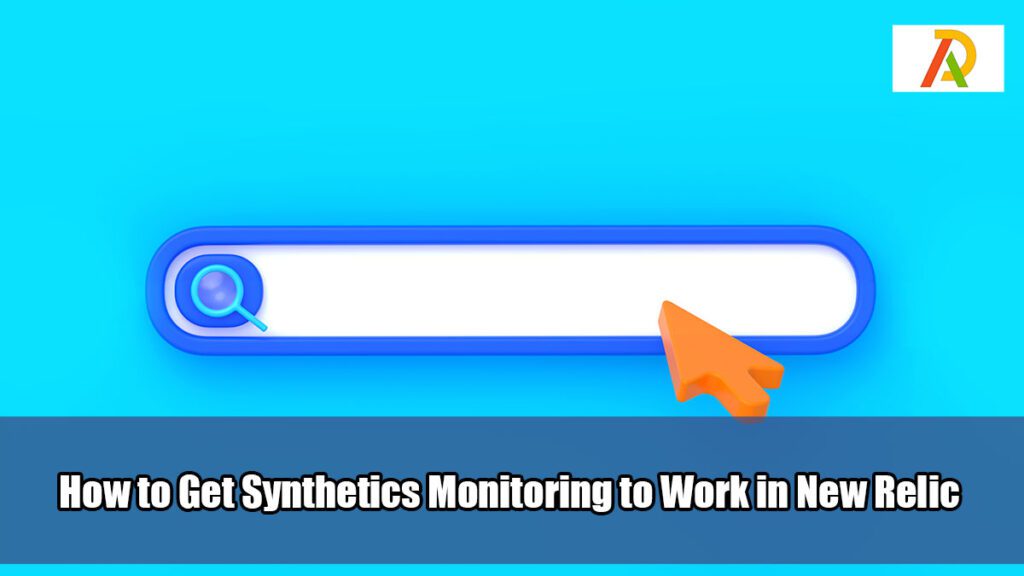How to Get Synthetics Monitoring to Work in New Relic

Maintaining smooth, seamless operations is essential in an age where online platforms significantly influence business performance. New Relic, a comprehensive digital performance analytics platform, enables businesses to monitor, troubleshoot, and optimize their software performance effectively. This article will focus on one of the platform’s most invaluable tools: Synthetics Monitoring. By the end, you will have a solid understanding of how to get Synthetics Monitoring to work in New Relic.
About New Relic Official Site
New Relic is a leading software analytics company that makes sense of billions of metrics about millions of applications in real-time. Their comprehensive Software-as-a-Service (SaaS) solution provides one powerful interface for web and native mobile applications and consolidates the performance monitoring data for any chosen technology in an environment. Here, you can find everything from real user and synthetic monitoring server monitoring, mobile monitoring, APM, and more.
The official New Relic website (www.newrelic.com) is the main hub for product offerings, updates, support resources, and more information. Here’s what you can typically find on the site:
1. Products: Detailed information about New Relic’s various offerings, including Application Performance Monitoring (APM), Infrastructure Monitoring, Log Management, Real User Monitoring (RUM), and Synthetic Monitoring.
2. Solutions: In-depth resources on how New Relic’s tools can help solve specific issues or needs in DevOps, SRE (Site Reliability Engineering), Cloud Migration, and Digital Customer Experience.
3. Resources: A wealth of resources to help users get the most out of New Relic. This includes documentation, video tutorials, webinars, reports, and a blog featuring tips, use cases, and industry trends.
4. Pricing: Detailed information about the pricing structure for New Relic’s various tools and plans.
5. Support: Access to New Relic’s customer support, including a comprehensive knowledge base, community forums, and contact information for direct support.
What is Synthetics Monitoring?
Synthetics Monitoring is a proactive tool used in digital performance analytics platforms like New Relic to monitor and test applications, websites, and APIs. This feature uses scripted simulations to mimic real user interactions, providing a mechanism to monitor software functionalities around the clock.
Here are the main aspects of Synthetics Monitoring:
1. Simulation of User Behavior: Synthetics Monitoring uses scripted transactions to simulate user behavior on a website or an application. This can include logging in, adding items to a cart, and checking out.
2. Performance Monitoring: The tool tracks application and website performance from different locations. This allows businesses to understand their application’s speed, reliability, and responsiveness from various global perspectives.
3. Continuous Monitoring: Unlike traditional testing methods typically executed during the development phase, Synthetics Monitoring runs continuously, even after the application is live. This ensures any potential issues that may affect end-users can be detected as soon as they occur.
4. API Monitoring: Synthetics Monitoring can also be used to monitor API endpoints’ availability, response time, and correctness of returned data.
5. Alerts: Synthetics Monitoring can send alerts to the responsible parties when performance issues are detected. This lets teams immediately identify and resolve issues, minimizing downtime and improving the overall user experience.
In summary, Synthetics Monitoring is vital for any business that values its digital user experience, providing real-time insights into application performance, functionality, and usability.
Setting Up Synthetics Monitoring in New Relic
Implementing Synthetics Monitoring in New Relic involves creating and configuring monitors that will continuously track your application’s performance. Below is a step-by-step guide to get you started.
Step 1: Accessing Synthetics
First, log into your New Relic account. Once you’re in, go to the top navigation menu. Among the options, you’ll find “Synthetics.” Click on this to access the Synthetics Monitoring section. If you’re using Synthetics for the first time, you’ll be greeted with an introduction and an option to “Create a monitor.”
Step 2: Creating a Monitor
Click on “Create a monitor.” This will present you with five monitor types you can choose from based on your requirements:
· Ping Monitor: This is the simplest form of monitor that checks whether your site is operational.
· Simple Browser: This monitor type takes it a step further by checking the page-load times of your website.
· Scripted Browser: This monitor allows you to write scripts that mimic user interactions and transactions on your site.
· API Test: If you need to monitor API endpoints, this tool is for you.
· Private Minion: This monitor lets you track applications within your private network.
Step 3: Configuring Your Monitor
Once you’ve selected the type of monitor that best suits your needs, you’ll be directed to a configuration page. Here, you’ll specify the URL you want to monitor, the frequency of monitoring, and the locations from which you want your site to be tested.
You’ll also need to script the interactions you want to monitor for Scripted Browser and API Test monitors. If you’re new to scripting, don’t worry – New Relic provides a library of scripts to help you get started.
Step 4: Setting Up Alerts
The final step in setting up Synthetics Monitoring is configuring alerts. This process involves specifying the conditions under which you would like to receive alerts regarding your site’s performance. For example, you can choose to be alerted if your site is down or if the page-load time exceeds a certain threshold.
You’ll have successfully set up Synthetics Monitoring in New Relic by following these steps. With everything configured, you can rest assured that your application’s performance will be continuously tracked, helping you maintain optimal user experience.
How do I monitor API in New Relic?
Monitoring APIs is an essential part of maintaining the health of your applications. New Relic allows you to do this effectively using their Synthetics tool. Here’s a step-by-step guide on how to monitor APIs in New Relic:
Step 1: Access Synthetics
After logging into your New Relic account, navigate to the top menu and select “Synthetics.”
Step 2: Create an API Test Monitor
In the Synthetics dashboard, click “Create a monitor.” A selection of different monitor types will appear. For API monitoring, select “API Test.”
Step 3: Configure the Monitor
On the configuration page, specify the details for the API endpoint you want to monitor. You’ll need to input the URL of your API endpoint and select the HTTP method (like GET, POST, PUT, DELETE) that the API uses.
Step 4: Set Up Request Data
Depending on the type of API and the HTTP method, you may need to provide additional request data, such as headers, parameters, or body data. For instance, if you’re setting up a POST request, you might need to specify the content type and provide a request body in JSON format.
Step 5: Write Validation Script (Optional)
You can also write a validation script to check the response from your API. This script will run after the API request and can check aspects like response status, headers, or body content. This is an optional but powerful way to ensure your API is not just responding but also returning the correct data.
Step 6: Set Monitor Locations and Frequency
Choose the locations from which you want to run the monitor and the frequency. The frequency can range from every minute to once per day, depending on your needs.
Step 7: Set Up Alerts
Lastly, set up alert conditions. This will determine when New Relic sends notifications about your API’s performance. You could be alerted, for instance, if the API response time exceeds a certain limit or if the API fails to respond.
After setting up, New Relic’s Synthetics Monitoring will begin tracking your API, allowing you to continuously monitor its performance, availability, and functionality. This proactive approach can help identify issues before they impact your users, ensuring a smooth and efficient digital experience.
Making the Most of Synthetics Monitoring
Tracking Application Performance
The Synthetics dashboard provides an overview of your application’s performance. It shows key metrics such as load time, response time, and error rates. You can track these metrics in real-time and over specific periods (hours, days, weeks, etc.), allowing you to quickly identify any sudden changes in performance.
Identifying and Troubleshooting Issues
Another vital feature of Synthetics Monitoring is its ability to highlight issues within your application. For example, if a particular webpage is taking too long to load or an API endpoint is consistently failing, these problems will be flagged on the dashboard. By clicking on these issues, you can access detailed reports to help identify the root cause – such as a problematic script or server-side issue.
You can configure alerts for specific issues or performance thresholds when setting up the monitors. When an alert is triggered, it provides valuable information that can help troubleshoot, such as stack traces, error messages, and snapshots of the webpage at the time of the error.
Analyzing Performance Trends
Synthetics Monitoring doesn’t just provide a snapshot of your application’s current performance and collects and stores performance data over time. This historical data can be invaluable in identifying long-term trends and patterns in your application’s performance.
For instance, you may notice that your application’s load time tends to increase at certain times of the day or on specific days of the week. This could indicate a pattern of high user traffic that your current infrastructure is struggling to handle.
Additionally, you might identify that performance issues often occur after new updates or changes are deployed, suggesting potential problems with certain updates or a need for more thorough pre-deployment testing.
Guiding Optimization Efforts
By identifying problem areas, performance trends, and their potential causes, Synthetics Monitoring provides crucial insights that can guide your optimization efforts. It enables you to focus on the areas that need improvement and make data-driven decisions about infrastructure upgrades, code optimizations, and changes in your deployment strategy.
In summary, once your monitors are set up, Synthetics Monitoring provides a wealth of data and insights that allow you to track, troubleshoot, and improve your application’s performance effectively.
Conclusion
New Relic’s Synthetics Monitoring is a powerful tool for maintaining and optimizing your digital platforms’ performance. While the setup process is relatively straightforward, understanding the different monitor types and configuring them to best suit your needs will ensure you get the most out of this tool. Remember, Synthetics Monitoring isn’t just about detecting issues; it’s about continuous improvement and optimization for an unbeatable user experience.


